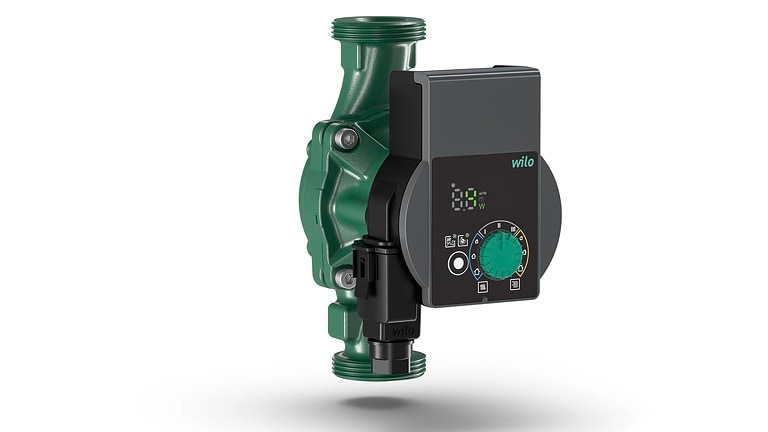Hydronic balancing of heating systems
90 per cent of heating systems are oversized or incorrectly adjusted. A key problem here is uneven heat distribution. Radiators that are close to the boiler receive a lot of warm water and get too hot. Radiators that are far away from the boiler receive too little warm water and remain too cold despite the heating being turned up. This results in expensive heating energy being wasted and limits the comfort in living spaces. Makeshift solutions such as increasing pump capacity or raising the feed temperature also result in increased heating costs and more environmental pollution. Not to mention annoying flow noises.
What hydronic balancing is all about as an installer
As an installer, you ensure that heat is optimally distributed in your customers’ homes with hydronic balancing. To do this, you limit the water flow rates to precisely the values that correspond to the maximum heating requirements. The flow rate of hot water is regulated at every consumer and precisely adjusted to the heating requirements of the room in question.
Hydronic balancing results in energy savings of 20 per cent
As an installer, you ensure that your customers benefit from energy savings of up to 20 per cent as a result of hydronic balancing – all for a relatively small investment. The fact that the heating system consumes less energy is also good for the environment. Not to mention that despite the lower energy consumption, every room in your customers’ homes is a comfortable temperature. All in all, you’re increasing customer satisfaction.
Got an old heating pump that’s faulty or due to be replaced?
The Wilo-Assistant will find the right replacement pump.
Simply scan your old pump’s rating plate with the Wilo-Assistant app to see your recommended replacement pump.
Or you can manually enter the type designation or article number.
The Wilo app gives you advice if a change to the piping is required for the new replacement pump. You’ll receive information including the necessary fitting pieces, saving you time and effort.
Wilo-Assistant AppDiscover our range of high-efficiency pumps for detached and semi-detached houses here:


FAQs for installers – frequently asked questions about hydronic balancing of heating systems
How can my customer tell if hydronic balancing is necessary?
The following tell-tale signs are a good indication for homeowners that their (underfloor) heating system requires hydronic balancing:
- The underfloor heating doesn’t get properly warm (all over or just in parts)
- Rooms do not reach the desired temperature
- Some radiators don’t get properly warm whereas others heat up very quickly
- The surface heating can barely be turned down
- The electricity consumption of the heating pump is very high
- The heating system requires a high feed temperature to heat up the rooms
- Flow noises in the heating system
What role does the circulator or high-efficiency pump play in hydronic balancing?
In heating systems, once a desired room temperature has been reached, the flow and thus the amount of heat required for the consumers is reduced (e.g. via a thermostatic valve on the radiator). Currently available circulators adjust the pump pressure provided to the flow rate (Dynamic Adapt plus or Δp-v control mode). This facilitates hydronic balancing. These Dynamic Adapt plus or Δp-v control modes only function properly and efficiently if the system is hydraulically balanced.
How are Wilo’s high-efficiency pumps adjusted after hydronic balancing?
After hydronic balancing, our heating pumps can be precisely adjusted to the required target delivery head (infinitely variable adjustment of the target delivery head). During implementation, all valves should be completely open. The current flow rate can then be read on the display and checked against the calculated flow rate. If these values match, hydronic balancing was successful. If the flow rate is different, the required flow rate can be easily corrected by adjusting the delivery head on the pump.
Is there also a digital support tool that facilitates hydronic balancing?
Does increasing the feed temperature do anything? What are the effects of this on the heating pump?
Increasing the feed temperature has no impact on the heating pump. Rather, it affects the heating system in general. Increasing the feed temperature reduces the efficiency of the heat generator. This is especially the case if it’s a heat pump that tends to have its efficient operating point in lower temperature ranges. This results in:
- Higher thermal losses in the pipe network
- Higher cycle times for the heat generator and thus increased wear
Can non-professionals carry out hydronic balancing themselves?
We recommend hiring a specialist installation company to carry out the hydronic balancing of the heating system. The installer is trained in hydronic balancing and also receives support through our digital tool. It has a function that enables hydronic balancing to be carried out according to a calculation. After entering all relevant parameters, there is a step-by-step guide including the setting on our pump itself.
Why do fixed-speed heating pumps cause noises in the heating system?
Due to the fact that fixed-speed heating pumps are unable to change their speed independently, noises may occur in the system especially in transition periods. They are caused by excessive flow velocities at the thermostatic valves. In contrast, modern high-efficiency pumps adjust their speed to the unit’s required volume flow. This prevents annoying flow noises in the heating systems. We recommend hydronic balancing and our high-efficiency circulators here.